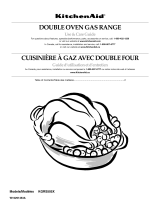
TABLE OF CONTENTS
OVEN SAFETY ................................................................................ 3
PARTS AND FEATURES ................................................................ 4
ELECTRONIC OVEN CONTROL ................................................... 5
Display(s) ...................................................................................... 5
Start .............................................................................................. 5
Off ................................................................................................. 5
Clock ............................................................................................ 6
Tones ............................................................................................ 6
Fahrenheit and Celsius ................................................................. 6
Options (combination oven models) ............................................ 6
Timer ............................................................................................. 6
Control Lock ................................................................................. 6
Oven Temperature Control .......................................................... 7
Sabbath Mode .............................................................................. 7
OVEN USE ....................................................................................... 8
Aluminum Foil............................................................................... 8
Positioning Racks and Bakeware ................................................ 8
Roll-Out Rack ............................................................................... 8
Bakeware ...................................................................................... 9
Meat Thermometer ....................................................................... 9
Oven Vent ................................................................................... 10
Baking and Roasting .................................................................. 10
Full and Center Broiling .............................................................. 10
Convection Cooking ................................................................... 11
Convection Bake ........................................................................ 11
Convection Roast ....................................................................... 12
Convection Broil ......................................................................... 13
EasyConvect TM Conversion ......................................................... 13
Proofing Bread ........................................................................... 13
Temperature Probe .................................................................... 14
Timed Cooking ........................................................................... 14
Dehydrating (on convection models, closed door) .................... 15
OVEN CARE .................................................................................. 15
Self-Cleaning Cycle .................................................................... 15
General Cleaning ........................................................................ 16
Oven Lights ................................................................................ 17
Oven Door .................................................................................. 17
TROUBLESHOOTING .................................................................. 18
ASSISTANCE OR SERVICE ......................................................... 19
In the U.S.A ................................................................................ 19
In Canada ................................................................................... 19
WARRANTY .................................................................................. 20
TABLE DES MATIERES
SECURITE DU FOUR ................................................................... 21
PIECES ET CARACTERISTIQUES .............................................. 22
COMMANDE ELECTRONIQUE DU FOUR ................................. 23
Afficheur(s) .................................................................................. 23
Mise en marche .......................................................................... 24
Arr_t ............................................................................................ 24
Horloge ....................................................................................... 24
Signaux sonores ......................................................................... 24
Fahrenheit et Celsius .................................................................. 24
Options (modeles de fours combines) ....................................... 24
Minuterie ..................................................................................... 25
Verrouillage des commandes ..................................................... 25
Commande de la temperature du four ...................................... 25
Mode Sabbat .............................................................................. 25
UTILISATION DU FOUR ............................................................... 26
Papier d'aluminium ..................................................................... 26
Positionnement des grilles et des ustensiles de cuisson .......... 26
Grille coulissante ........................................................................ 27
Ustensiles de cuisson ................................................................ 28
Thermometre a viande ............................................................... 28
Event du four .............................................................................. 29
Cuisson au four et rGtissage ...................................................... 29
Cuisson au gril complet et central ............................................. 29
Cuisson par convection ............................................................. 30
Cuisson au four par convection ................................................. 30
RGtissage par convection .......................................................... 31
Cuisson au gril par convection ................................................... 32
Conversion de la temperature de
convection EasyConvect TM. ......................................................... 32
Levee du pain ............................................................................. 33
Sonde thermometrique .............................................................. 33
Cuisson minutee ......................................................................... 34
Deshydratation (modeles a convection - porte fermee) ............ 34
ENTRETIEN DU FOUR ................................................................. 35
Programme d'autonettoyage ..................................................... 35
Nettoyage genGral ...................................................................... 36
Lampes du four .......................................................................... 37
Porte du four ............................................................................... 37
DEPANNAGE ................................................................................. 38
ASSISTANCE OU SERVICE ......................................................... 39
GARANTIE ..................................................................................... 39




















